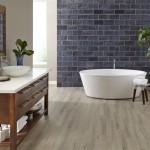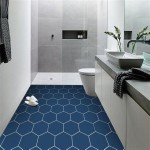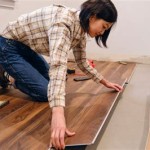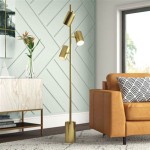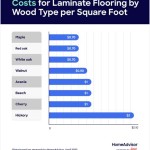Living Room Ideas: Embracing the Comfort and Versatility of Floor Seating
Floor seating presents a compelling alternative or supplement to traditional furniture arrangements in the living room. It offers a relaxed, informal atmosphere, fostering a sense of community and encouraging flexible use of space. Far from being limited to bohemian aesthetics, floor seating can be integrated into a variety of design styles, ranging from minimalist modern to eclectic vintage. The key to successful implementation lies in understanding the different types of floor seating available, considering comfort and ergonomics, and strategically incorporating them into the overall design plan.
The growing popularity of floor seating stems from several factors. Firstly, it caters to a desire for more adaptable living spaces. Unlike fixed sofas and armchairs, floor cushions and poufs can be easily moved and rearranged to accommodate different activities, from intimate gatherings to individual relaxation. Secondly, it offers a visual break from the often-stuffy formality of traditional living rooms. The lower profile of floor seating creates a sense of spaciousness and openness, particularly beneficial in smaller apartments or homes. Finally, it resonates with a contemporary lifestyle that prioritizes comfort, informality, and connection.
Exploring Different Types of Floor Seating
The world of floor seating encompasses a diverse range of options, each with its own unique characteristics and suitability for different needs and preferences. Understanding these options is the first step in creating a functional and aesthetically pleasing floor seating arrangement.
Cushions: Perhaps the most ubiquitous form of floor seating, cushions come in an array of shapes, sizes, and materials. Large, square cushions offer ample support for lounging, while smaller, round cushions are ideal for casual seating or decorative accents. The choice of materials is crucial for both comfort and durability. Cotton and linen are breathable and comfortable for everyday use, while velvet and silk add a touch of luxury. Firm cushions provide better back support, while softer cushions offer a more relaxed feel. Consider the intended use and the overall aesthetic of the room when selecting cushions.
Poufs: Poufs are another popular choice, offering a versatile seating option that can also serve as a footrest or side table. They are typically made from materials like leather, fabric, or knitted yarn, and filled with beans, foam, or fiberfill. Leather poufs offer a sophisticated and durable option, while fabric poufs provide a softer and more casual feel. Knitted poufs add texture and visual interest to the space. The size and shape of the pouf should be proportionate to the room and the other furniture. Larger poufs can serve as primary seating, while smaller poufs are better suited for accents or footrests.
Floor Chairs: Floor chairs provide a more structured and supportive seating option than cushions or poufs. They typically feature a foldable frame that allows them to be adjusted to different angles. Floor chairs are ideal for reading, watching television, or working on a laptop. They come in a variety of styles, from minimalist designs to more ornate options with armrests and headrests. Consider the level of support and adjustability when selecting a floor chair. Some models offer lumbar support and adjustable headrests for added comfort.
Zafu and Zabuton: Traditionally used for meditation, zafu and zabuton sets are also gaining popularity as floor seating options. A zafu is a round or crescent-shaped cushion, typically filled with kapok or buckwheat hulls. A zabuton is a larger, rectangular mat that provides cushioning for the knees and ankles. These sets offer a comfortable and supportive seating option for relaxation and mindfulness practices. They can also be incorporated into a more general floor seating arrangement to add a touch of tranquility to the space.
Low Sofas or Sectionals: While technically not "floor seating" in the strictest sense, low sofas and sectionals create a similar effect by being significantly lower to the ground than traditional sofas. These pieces often have minimal or no legs, giving the appearance of being grounded and integrated into the floor. They are a good option for those who want the comfort and support of a sofa but still desire the informal feel of floor seating.
Prioritizing Comfort and Ergonomics in Floor Seating Design
While aesthetics are important, comfort and ergonomics should be paramount considerations when designing a floor seating arrangement. Spending extended periods sitting on the floor can strain the back, neck, and hips if proper support is not provided. Therefore, it is essential to choose seating options that promote good posture and minimize discomfort.
Back Support: Adequate back support is crucial for maintaining good posture and preventing back pain. Opt for cushions or floor chairs that provide sufficient lumbar support. Consider using backrests or cushions against walls or other solid surfaces to provide additional support. Experiment with different cushion arrangements to find the most comfortable and supportive configuration.
Proper Cushion Height: The height of the floor seating should be appropriate for the user's leg length and body type. Sitting too low can strain the knees and hips, while sitting too high can cause discomfort in the lower back. Aim for a height that allows the knees to be slightly bent and the hips to be slightly higher than the knees. This position promotes good circulation and reduces strain on the joints.
Material Selection: The choice of materials can significantly impact the comfort of floor seating. Natural materials like cotton, linen, and wool are breathable and comfortable for prolonged use. Synthetic materials like polyester and acrylic can be more durable and stain-resistant but may not be as breathable. Consider the climate and the intended use when selecting materials. In warmer climates, breathable materials are essential for preventing overheating. In high-traffic areas, durable and stain-resistant materials are preferable.
Layering and Texture: Layering cushions and textures can enhance both the comfort and visual appeal of a floor seating arrangement. Combining cushions of different sizes, shapes, and materials creates a more inviting and comfortable space. Adding throws and blankets provides extra warmth and texture. Consider using a variety of textures, such as velvet, linen, and wool, to create visual interest and tactile appeal.
Accessibility Considerations: When designing a floor seating arrangement, it's important to consider the accessibility needs of all users. Floor seating can be challenging for individuals with mobility issues, such as older adults or people with disabilities. Provide alternative seating options, such as chairs or stools, for those who may have difficulty getting up and down from the floor. Ensure that the floor seating area is well-lit and free of obstacles to prevent falls.
Integrating Floor Seating into the Overall Living Room Design
Successfully incorporating floor seating into the living room design requires careful planning and consideration of the existing furniture, the room's layout, and the overall aesthetic. The goal is to create a cohesive and functional space that seamlessly integrates floor seating with other design elements.
Defining the Space: Use rugs to define the floor seating area and visually separate it from the rest of the room. A large area rug can serve as a foundation for the seating arrangement, providing a comfortable and cohesive base. The rug should be large enough to accommodate all of the floor seating elements and extend slightly beyond the perimeter of the arrangement. Consider the color and pattern of the rug when selecting floor seating cushions and poufs. Choose colors and patterns that complement the rug and create a harmonious look.
Creating a Focal Point: Establish a focal point within the floor seating area to draw the eye and create a sense of visual balance. This could be a coffee table, a fireplace, a piece of artwork, or a decorative object. The focal point should be strategically positioned to create a sense of order and visual interest. Consider using a low coffee table or a stack of books to serve as a surface for drinks and snacks. A fireplace can create a warm and inviting atmosphere, while a piece of artwork can add personality and visual appeal.
Balancing Heights: To prevent the floor seating area from feeling too low and disconnected from the rest of the room, incorporate elements of varying heights. This could include adding a low side table, a tall plant, or a floor lamp. These elements will help to create visual interest and balance the overall proportions of the space. Consider using a tall plant to add a touch of greenery and create a sense of verticality. A floor lamp can provide task lighting for reading or other activities.
Color and Texture: The color and texture of the floor seating elements should complement the overall color palette and texture of the living room. Choose colors that are harmonious and visually appealing. Consider using a variety of textures to add visual interest and tactile appeal. Incorporate patterns and prints to add personality and visual flair. Experiment with different combinations of colors, textures, and patterns to find the perfect balance for the space.
Lighting: Adequate lighting is essential for creating a comfortable and functional floor seating area. Use a combination of ambient, task, and accent lighting to create a well-lit and inviting space. Ambient lighting provides overall illumination, while task lighting provides focused light for reading or other activities. Accent lighting highlights specific features or artwork. Consider using dimmers to adjust the lighting to suit different moods and activities. Use a variety of light sources, such as ceiling fixtures, floor lamps, and table lamps, to create a layered and dynamic lighting scheme.
Personalization: Finally, personalize the floor seating area with personal touches that reflect the user's individual style and preferences. This could include adding family photos, travel souvenirs, or other decorative objects. These personal touches will make the space feel more comfortable and inviting. Consider incorporating elements that are meaningful and sentimental to the user. This will create a space that is truly unique and personal.
The successful integration of floor seating into a living room requires careful consideration of comfort, ergonomics, and overall design. By understanding the different types of floor seating available, prioritizing comfort and support, and strategically incorporating these elements into the overall design plan, it is possible to create a living room that is both stylish and functional.

Living Room Seating Ideas To Elevate Your Home Decor

25 Comfortable Living Room Seating Ideas Without Sofa

Beige Sofa Velvet Floor Cushion Couch Boho Design Moroccan Seating Living Room Seat Arabic Majlis Etsy

Floor Seating Ideas For Comfort And Style Designcafe

31 Floor Sitting Ideas

Hippie Decor Set Floor Seating Area Boho Canopy With Decorative Cushions And Pillow Covers Unique Bohemian Meditation Room

Revisiting The Concept Of Floor Seating Closet To Curtains

Great Floor Seating Ideas For Comfort And Style Beautiful Homes

Floor Seating Ideas For Modern Living Room Sofa Fs Fashion World

Seating Urban Den
